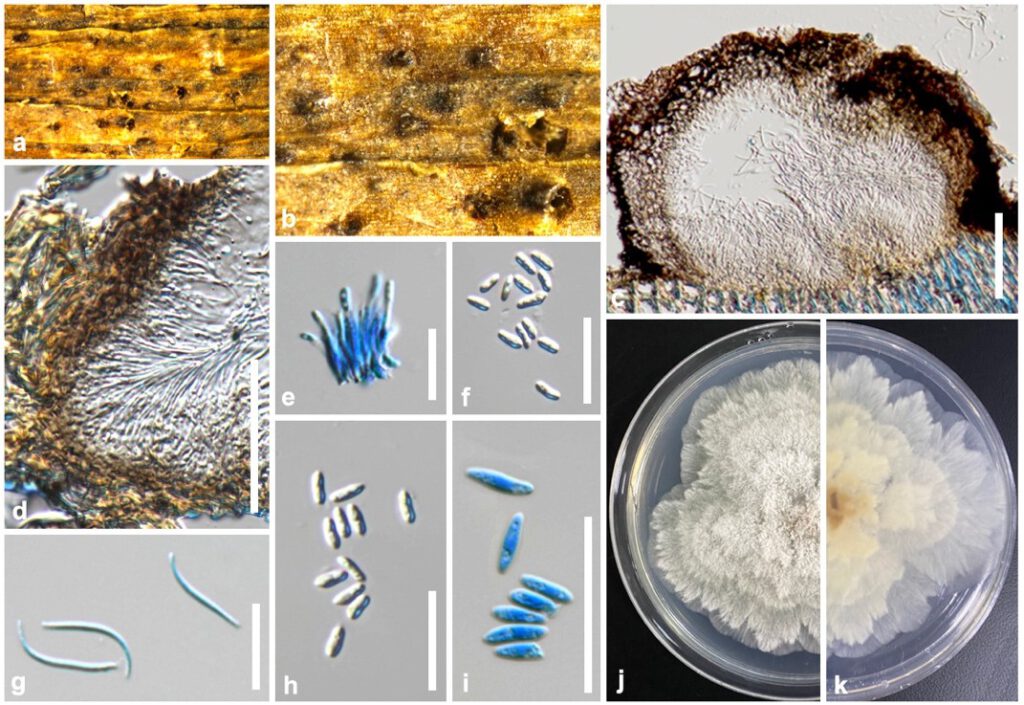Diaporthe circularis Y.Y. Chen, A.J. Dissanayake and Jian K. Liu sp. nov. (Figure g)
MycoBank number: MB; Index Fungorum number: IF; Faces of fungi number: FoF 12618;
Etymology: Refers to the formation of concentric rings in PDA media.
Holotype: GZAAS 22-0038
Saprobic on decaying wood. Sexual morph: Not observed. Asexual morph: Conidiomata 230–360 μm diam., globose to subglobose, erumpent at maturity. Peridium up to 30–50 μm diam., parenchymatous, consisting of 3–4 layers of medium brown textura angularis. Conidiophores 20–45 × 2–2.4 μm, cylindrical, hyaline, smooth, branched, ampulliform, straight to sinuous. Conidiogenous cells up to 0.5–1 μm, phialidic, cylindrical, terminal, with slight tapering towards apex. Paraphyses 20–30 × 1–2 μm, abundant among conidiophores. Alpha conidia (6–)7–8(–9) × 2–3 μm ( = 7 × 3, n = 30), aseptate, hyaline, smooth, ovate to ellipsoidal, biguttulate, base subtruncate. Beta conidia (17–)20–23(–25) × (3–)3–4(–4.5) μm ( = 22 × 3, n = 30), aseptate, hyaline, smooth, fusiform or hooked, base subtruncate.
Culture characteristics: Colonies on PDA flat, with an entire edge, mycelium growing in concentric rings, cottony texture, white to smoke-grey; colonies covering entire PDA Petri dishes after 10 d at 25 °C; reverse buff and isabelline.
Material examined: China, Guizhou Province, Xingyi city, saprobic on decaying woody host, June 2020, Y. Y. Chen (GZAAS 22-0038, holotype); ex-type living culture CGMCC = GZCC GZCC 22-0037; ibid, Guiyang District, saprobic on decaying woody host, July 2020, Y. Y. Chen (GZAAS 22-0047, paratype), living culture GZCC 22-0046.
Notes: The phylogenetic results showed that two isolates of Diaporthe circularis clustered closer to D. ellipsospora, D. jinxiu and D. psoraleae-pinnatae forming a distinct lineage (Figure 2) with maximum support (ML/MP/BI = 100/100/1.0). Diaporthe circularis can be distinguished from D. ellipsospora in the concatenated alignment by 11/512 in ITS, 7/413 in tef, 9/453 in tub, 2/506 in cal and 11/515 in his while it could be differentiated from D. jinxiu by 11/512 in ITS, 7/413 in tef, 9/453 in tub, 2/506 in cal and 11/515 in his and from D. psoraleae-pinnatae by 29/512 in ITS, 11/413 in tef, 12/453 in tub, 2/506 in cal and 5/515 in his. As D. circularis has no reported sexual morph, we were unable to compare its morphological features with D. ellipsospora (Dissanayake et al. 2020). Diaporthe circularis differs from D. jinxiu in having concentric rings in PDA media (Wang et al. 2021) and from D. psoraleae-pinnatae in having shorter alpha conidia (Crous et al. 2013).

Figure g. Diaporthe circularis (GZAAS 22-0038, holotype). a, b Conidiomata on host surface. c, d Section of conidiomata. e Alpha conidia attached to conidiophores stained in methylene blue. f, h Alpha conidia. g Beta conidia stained in methylene blue. i Alpha conidia stained in methylene blue. j 10 days old culture on PDA from above. k 10 days old culture on PDA from reverse. Scale bars: c, d = 100 μm; e–i = 20 μm.
